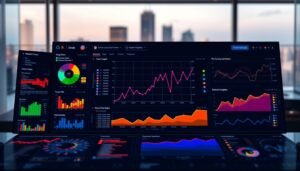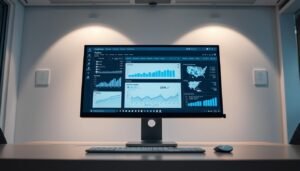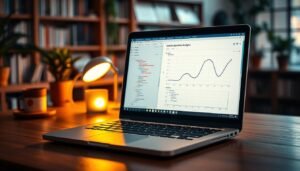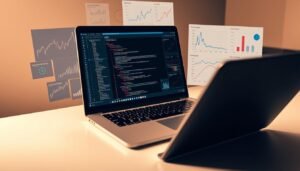Starting your data science journey is an exciting adventure in today’s tech world. As we look towards 2025, data science is growing, with many opportunities for those eager to start. You’ll learn about machine learning, data visualizations, and more, making your path to becoming a data scientist rewarding.
In this guide, we’ll cover the key skills and tools for success in big data analytics and AI. Whether you’re new or looking to improve, we offer practical tips and insights. These will help you excel in this fast-paced field.
Key Takeaways
- Master core programming languages for data analysis
- Develop strong skills in predictive modeling
- Learn to create impactful data visualizations
- Understand the fundamentals of machine learning processes
- Stay updated with the latest big data analytics tools
- Cultivate problem-solving skills for real-world challenges
Understanding the Data Science Journey
Starting data science journey is both exciting and rewarding. This guide will help you understand the path to becoming a data scientist. It highlights the key aspects and why this field is so appealing.
The Allure of Data Science
Data science combines problem-solving, creativity, and technical skills. As businesses rely more on data, the need for skilled professionals grows. You can make a big difference by finding insights that shape strategies and drive innovation.
Industry Demands and Future Outlook
The job market for data scientists is booming. Opportunities exist in many industries. Companies want to use data effectively, leading to a high demand for experts.
| Year | Projected Job Growth | Average Salary |
|---|---|---|
| 2025 | 28% | $126,000 |
| 2030 | 36% | $145,000 |
Milestones on Your Learning Path
Starting data science journey needs a clear plan. Your roadmap should include learning programming languages, understanding statistics, and gaining practical experience. Here are important milestones:
- Learn Python or R programming
- Master data manipulation and analysis
- Develop machine learning skills
- Build a portfolio of projects
- Gain industry certifications

Becoming a data scientist is a journey of continuous learning. Stay curious, keep practicing, and embrace new challenges to succeed in this dynamic field.
Essential Technical Skills for Aspiring Data Scientists
To succeed in data science, you need strong technical skills. This field is all about working with complex data to find valuable insights. You’ll learn many tools and techniques along the way.

Python is a key skill for data scientists. It’s great for handling data and learning from it. R programming is also important, as it helps with statistics and visualizing data.
Statistical analysis is at the heart of data science. It lets you understand data, test ideas, and make smart choices. With data mining, you can find patterns in big datasets.
The machine learning path is vital for data scientists. It teaches you about algorithms and how to evaluate models. As AI grows, data science and AI careers become more connected, leading to new tech opportunities.
“Data science is not just about crunching numbers; it’s about solving real-world problems with data-driven insights.”
To do well in data science, focus on these key skills:
- Proficiency in programming languages (Python, R)
- Strong foundation in statistics and mathematics
- Experience with data mining and machine learning techniques
- Familiarity with big data technologies
- Data visualization and storytelling skills
| Skill | Importance | Learning Resources |
|---|---|---|
| Python Programming | High | Coursera, DataCamp, edX |
| R Programming | Medium | R for Data Science, Udacity |
| Statistical Analysis | High | Khan Academy, Stat Trek |
| Machine Learning | High | Stanford Online, Fast.ai |
| Data Mining | Medium | IBM Skills Network, Kaggle |
By mastering these skills, you’ll lay a solid foundation for a rewarding career in data science.
Programming Languages Every Data Scientist Must Master
Mastering key programming languages is key for data science success. Let’s look at the essential tools for your coding journey.
Python for Data Analysis and Machine Learning
Python is the top choice for data scientists. It’s versatile and has many libraries. You can use it for data manipulation with Pandas and machine learning with Scikit-learn.
R Programming for Statistical Computing
Starting with R opens up powerful statistical analysis. R is great for making beautiful visualizations and complex statistical tasks. It’s also top in biostatistics and finance.
SQL for Database Management
SQL mastery is a must for data scientists. It helps you manage and query large datasets. It’s the language of databases, making data extraction, transformation, and loading precise.
| Language | Primary Use | Key Libraries/Tools |
|---|---|---|
| Python | General-purpose, ML | Pandas, NumPy, Scikit-learn |
| R | Statistical analysis | ggplot2, dplyr, tidyr |
| SQL | Database querying | MySQL, PostgreSQL, SQLite |
By focusing on these three languages, you’ll lay a strong foundation for your data science career. Remember, practice is essential to become proficient in coding for data science.
Building Your Statistical and Mathematical Foundation
A strong foundation in statistics and math is key for data science success. This journey into statistics sets the stage for mastering statistical modeling. It also starts your statistical computing odyssey.
Core Statistical Concepts
Understanding core statistical concepts is vital for data analysis. These include descriptive and inferential statistics, and hypothesis testing. Descriptive statistics summarize data, while inferential statistics help us draw conclusions from samples. Hypothesis testing is essential for making informed decisions.
Linear Algebra and Calculus Basics
Linear algebra and calculus are critical for advanced statistical modeling techniques. It works with vectors and matrices, important for machine learning. Calculus is used in optimization and understanding neural networks.
Probability Theory Fundamentals
Probability theory is the base of statistical inference. It helps us understand uncertainty and make predictions. Key concepts include random variables, probability distributions, and Bayes’ theorem. These are the foundation for many machine learning algorithms and statistical models.
| Mathematical Area | Key Concepts | Applications in Data Science |
|---|---|---|
| Statistics | Descriptive, Inferential, Hypothesis Testing | Data Analysis, Decision Making |
| Linear Algebra | Vectors, Matrices | Machine Learning Algorithms |
| Calculus | Derivatives, Integrals | Optimization, Neural Networks |
| Probability | Distributions, Bayes’ Theorem | Predictive Modeling, Uncertainty Quantification |
Mastering these mathematical foundations is vital for your statistical computing journey. They give you the tools to understand complex algorithms, create innovative solutions, and excel in data science.
Machine Learning and AI Fundamentals
Machine learning and artificial intelligence are key parts of modern data science. They help drive new ideas in many fields, like healthcare and finance. Knowing these areas well is important for data scientists to succeed.
Machine learning algorithms get better with time by learning from data. They are great at things like recognizing images and understanding language. AI systems try to think like humans, solving tough problems and making choices.
Important machine learning ideas include supervised and unsupervised learning, neural networks, and deep learning. These ideas help make many modern technologies, like self-driving cars and personalized ads.
Machine learning is the science of getting computers to act without being explicitly programmed.
Artificial intelligence covers a wide range of areas, like expert systems and robotics. AI helps with virtual assistants, chatbots, and making decisions in many fields.
To do well in data science, you must learn to solve problems with algorithms. This means getting good at different ML and AI methods, knowing how to use them, and when.
| Machine Learning Technique | Application | Example |
|---|---|---|
| Supervised Learning | Classification, Regression | Spam email detection |
| Unsupervised Learning | Clustering, Dimensionality Reduction | Customer segmentation |
| Reinforcement Learning | Game AI, Robotics | AlphaGo |
| Deep Learning | Image Recognition, NLP | Face recognition systems |
By learning these basics, you’ll be ready to handle big data science challenges. You’ll also help bring new ideas to your field.
Data Visualization and Storytelling Techniques
Data visualization makes complex info easy to understand. By using the right tools, you can tell stories that grab your audience’s attention. Let’s look at some top tools and best practices for presenting data well.
Popular Visualization Tools
Choosing the right tools for data visualization is key. Here are some top picks:
- Tableau: Known for its user-friendly interface and powerful features
- Power BI: Microsoft’s tool for creating interactive dashboards
- D3.js: A JavaScript library for custom, web-based visualizations
- Python libraries: Matplotlib, Seaborn, and Plotly for versatile charting options
Creating Impactful Data Stories
Data visualization storytelling is more than charts and graphs. It’s about telling a story that grabs your audience. Start with a clear message, pick visuals that support your story and guide your viewers through the data.
Best Practices in Data Presentation
To make your data visualizations stand out, remember these tips:
- Simplify: Don’t clutter your visuals with too much info
- Use color wisely: Pick a palette that helps understanding
- Label clearly: Make sure your axes and legends are easy to read
- Be consistent: Use the same style for related visuals
- Tell a story: Connect your data points to create a compelling narrative
| Visualization Type | Best Used For | Example |
|---|---|---|
| Bar Charts | Comparing categories | Sales by product |
| Line Graphs | Showing trends over time | Stock prices |
| Pie Charts | Displaying parts of a whole | Market share |
| Scatter Plots | Revealing relationships | Height vs. weight |
Big Data Tools and Cloud Computing Platforms
Data science heavily relies on big data frameworks and cloud computing. These tools help data scientists work with huge datasets and do complex analyses. Let’s look at some key technologies in this area.
Apache Hadoop and Spark
Apache Hadoop is a key player in big data. It lets computers work together to process big data sets. Spark, built on Hadoop, is faster for some tasks.
Cloud Services for Data Science
Cloud computing has changed data science. Amazon Web Services, Google Cloud, and Microsoft Azure offer scalable resources. They have powerful tools for machine learning and data visualization.
Data Storage and Processing Solutions
Good data storage and processing are vital for big data. NoSQL databases like MongoDB and Cassandra are great for unstructured data. Apache Kafka is popular for real-time processing.
| Tool | Use Case | Key Feature |
|---|---|---|
| Hadoop | Distributed storage | Scalability |
| Spark | Fast processing | In-memory computation |
| AWS | Cloud computing | Wide range of services |
| MongoDB | NoSQL database | Flexible schema |
Knowing these big data tools and cloud platforms is key for data scientists today. They help handle huge datasets and complex analyses. This opens up new possibilities in data science.
Building Your Data Science Portfolio
Creating a strong portfolio is key when you learn data science from scratch. It’s your chance to showcase your skills and stand out in the competitive field of entry-level data science jobs. Your portfolio should reflect Data science journey and highlight the data science skills for beginners you’ve mastered.
Start by selecting projects that demonstrate your abilities. Choose diverse tasks that cover different aspects of data analysis, machine learning, and visualization. This variety will show your versatility and readiness for a data scientist career path.
- Analyze a public dataset and present insights
- Build a machine learning model to solve a real-world problem
- Create an interactive dashboard using tools like Tableau or Power BI
- Contribute to open-source data science projects on GitHub
When presenting your work, focus on clarity and impact. Explain your process, from data cleaning to final results. Use visuals to make your findings easy to understand. Remember, your portfolio is not just about the code – it’s about showing how you think and solve problems.
“A well-crafted portfolio is your ticket to landing that first data science role. It proves you can apply your skills to real-world challenges.”
Keep your portfolio up-to-date as you continue to learn and grow. This ongoing effort will demonstrate your commitment to the field and your ability to adapt to new technologies and techniques. With a strong portfolio, you’ll be well-equipped to impress employers and kickstart your data science career.
Networking and Professional Development Strategies
a successful data science journey is not just about technical skills. Networking and learning continuously are key. Let’s look at important strategies to grow your career and find more opportunities in data science.
Industry Conferences and Events
Going to data science conferences and events is key for career growth. These events share the latest trends and offer great chances to network. KDD, ODSC, and AI & Big Data Expo are some top events. They can lead to valuable connections and job chances for data scientists.
Online Communities and Resources
Being part of online communities is vital for staying current and connecting with others. Sites like Kaggle, Stack Overflow, and GitHub are great for working on projects and showing off your skills. These places offer advice for data scientists and help find new jobs.
- Kaggle: Join competitions and talk about data science
- Stack Overflow: Ask questions and share knowledge with others
- GitHub: Work on open-source projects and build your portfolio
Mentorship Opportunities
Finding a mentor can really speed up your data science career. Experienced people can share insights and help you navigate the field. Look for mentorship programs or reach out to data scientists you admire on LinkedIn. Remember, mentorship works both ways – be ready to give back for their help.
“The best way to predict the future is to create it.” – Peter Drucker
By joining conferences, online communities, and mentorship programs, you’ll improve your skills, grow your network, and find exciting job opportunities. These steps will keep you ahead in the changing world of data science.
Conclusion
Starting your data science journey is thrilling, with many paths to explore. You’ve learned that skills like programming, statistics, and machine learning are key. But, success also means always learning and keeping up with new tech.
To really shine, you must apply what you’ve learned. Building a strong data science portfolio is vital to show off your skills to employers. Begin by solving real problems and sharing your work online. This way, you’ll not only improve your skills but also show your passion for data science.
As you move forward, make sure to use online resources and join communities. There are many tips and tricks to help you stay motivated and overcome hurdles. Connecting with others in the field can offer insights and new chances. So, start now stay curious and enjoy the data science journey to becoming a data scientist!
FAQ
What are the essential skills needed to start a career in data science?
To start in data science, you need technical and soft skills. You should know Python and R, SQL for databases, and have strong stats skills. Also, knowing machine learning is key.
Soft skills like critical thinking and communication are just as important. Learning to visualize data helps present your findings well.
How long does it typically take to become proficient in data science?
How long it takes to get good at data science varies. It can be 6 months to 2 years for beginners. If you know programming or stats, you might learn faster.
Data science is always evolving. Even pros keep learning new things.
Which programming language should I learn first for data science: Python or R?
Python is a good start for beginners. It’s easier to learn and very useful. R is great for stats and has lots of data science packages.
Learning both Python and R makes you versatile. But, Python is a good first choice.
What kind of projects should I include in my data science portfolio?
Your portfolio should show off your skills with different projects. Include data analysis, machine learning, and visualization projects. Mix personal and real-world projects.
Some ideas are predictive models, exploratory data analysis, and data visualizations. Explain your process and insights for each project.
How important is a strong mathematical background for success in data science?
A strong math background is key for data science. You need to know stats, linear algebra, and calculus. These basics help you understand algorithms and models.
You don’t have to be a math expert. But, knowing these basics helps a lot in your projects.
What are some good resources for learning data science online?
There are many great online resources for data science. Try Coursera’s Data Science Specialization and edX’s Professional Certificate. DataCamp and Kaggle are also good.
Don’t forget MIT OpenCourseWare and Udacity. Practice with real projects to improve your skills.
How can I stay up-to-date with the latest trends and advancements in data science?
To keep up with data science, follow blogs like KDnuggets and Towards Data Science. Join online communities like Reddit’s r/datascience. Attend conferences and meetups.
Follow data scientists on Twitter and LinkedIn. Work on personal projects and try new tools to stay current.






















16 thoughts on “How to Start a Data Science Journey in 2025: Complete Guide”
I?¦ve learn several just right stuff here. Definitely worth bookmarking for revisiting. I surprise how much attempt you put to create one of these great informative site.
you are really a excellent webmaster. The web site loading speed is amazing. It seems that you’re doing any distinctive trick. Moreover, The contents are masterwork. you have performed a fantastic job in this matter!
I think this is among the most important information for me. And i’m glad reading your article. But want to remark on few general things, The website style is great, the articles is really great : D. Good job, cheers
Some really excellent articles on this internet site, appreciate it for contribution.
Hi! This is kind of off topic but I need some advice from an established blog. Is it hard to set up your own blog? I’m not very techincal but I can figure things out pretty quick. I’m thinking about creating my own but I’m not sure where to start. Do you have any tips or suggestions? Many thanks
Wonderful post but I was wanting to know if you could write a litte more on this topic? I’d be very grateful if you could elaborate a little bit further. Appreciate it!
I like what you guys are up also. Such clever work and reporting! Carry on the superb works guys I have incorporated you guys to my blogroll. I think it will improve the value of my web site 🙂
I want looking through and I conceive this website got some really useful stuff on it! .
WONDERFUL Post.thanks for share..more wait .. …
Howdy would you mind letting me know which hosting company you’re utilizing? I’ve loaded your blog in 3 different internet browsers and I must say this blog loads a lot faster then most. Can you suggest a good web hosting provider at a honest price? Thanks, I appreciate it!
Hi there! I know this is kinda off topic however , I’d figured I’d ask. Would you be interested in trading links or maybe guest writing a blog article or vice-versa? My blog covers a lot of the same subjects as yours and I believe we could greatly benefit from each other. If you happen to be interested feel free to shoot me an e-mail. I look forward to hearing from you! Superb blog by the way!
Woh I enjoy your articles, saved to fav! .
Very efficiently written article. It will be valuable to anyone who employess it, including me. Keep up the good work – looking forward to more posts.
Hiya, I am really glad I have found this info. Today bloggers publish just about gossips and internet and this is really annoying. A good website with exciting content, that’s what I need. Thank you for keeping this web-site, I’ll be visiting it. Do you do newsletters? Can’t find it.
With the whole thing that appears to be building inside this particular subject material, all your points of view happen to be fairly stimulating. On the other hand, I beg your pardon, but I can not give credence to your entire theory, all be it exciting none the less. It looks to everybody that your opinions are not totally justified and in actuality you are generally yourself not even wholly certain of your point. In any case I did enjoy reading through it.
Currently it seems like Drupal is the top blogging platform available right now. (from what I’ve read) Is that what you are using on your blog?